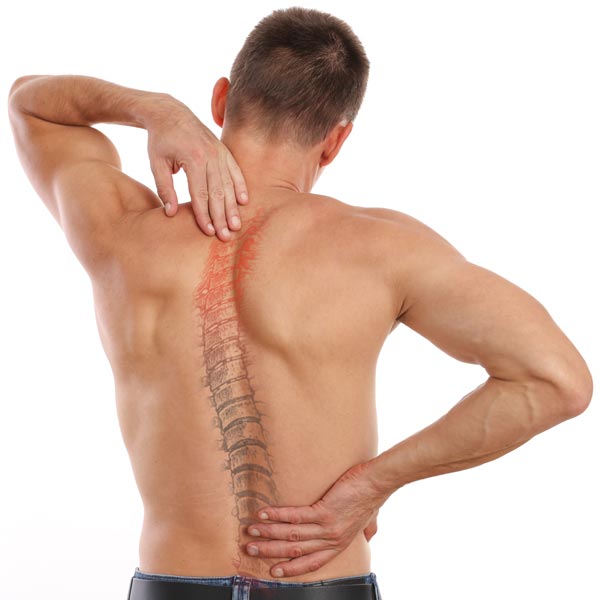What Are My Options for Addressing Scoliosis without Scoliosis Surgery?

Scoliosis affects up to three percent of the population in the United States, equating to approximately nine million people. Diagnosis can occur as early as infancy or early childhood, but onset and detection most common in later childhood or even adolescence. Scoliosis can put a major burden on an individual’s quality of life, since sufferers are significantly more likely to develop back pain and, as a result, loss of productivity.
Often, people think a scoliosis diagnosis will require scoliosis surgery. Luckily, less than 10% of people will need surgery. Plus, this number could be even smaller with the right understanding of well-researched conversative treatment options, such as a scoliosis brace and/or scoliosis exercises.
What is Scoliosis?
Scoliosis is simply defined as an abnormal curve of the spine. A normal spine can rest in a neutral position that creates a shallow “S” shape in the sagittal plane (sideways). This means that the spine is neither rotated or excessively curved at rest. Scoliosis is most often diagnosed by an orthopedic or neurological doctor with a combination of a physical exam and imaging, such as an x-ray or CT scan.
The abnormal curves associated with scoliosis are broken up into three primary categories. Any curve measured beyond 10 degrees is considered scoliosis. Each category is determined by the degree of curvature that is measured by a healthcare professional and imaging. These include:
- 10 to 25 degrees is classified as mild
- A curve greater than 25 degrees and up to 49 degrees is classified as significant
- Any curve greater than 50 degrees is significant – often leading to severe spine instability, poor neural integrity, and organ compromise
What Causes Scoliosis and How is it Classified?
There are three types of scoliosis: idiopathic, congenital, and neurological. Risk factors related to developing any type of scoliosis include being female and family history.
- Idiopathic scoliosis.
Idiopathic scoliosis is the most common type and the underlying causes are largely unknown. This category accounts for as many as 80% of scoliosis cases. Classification for idiopathic scoliosis is broken up into categories based on the age it is present, including infant (0-3), juvenile (4-10), adolescent (11-18), and adult (18+).
- Congenital scoliosis.
Congenital scoliosis is defined as a spine deformity that is current at birth. This most often due to improperly formed vertebrae.
- Neurological scoliosis.
Neurological scoliosis is secondary to nerve dysfunction that affects muscle tension. This is most often due to neurological disorders such as a spinal cord injury, cerebral palsy, muscular dystrophy, or spina bifida.
Additionally, scoliosis can also be categorized as structural or nonstructural. Structural scoliosis is considered permanently fixed as a result of a birth defect, injury, or disease. There is minimal flexibility to the spine curvature. Whereas, nonstructural scoliosis refers to flexible temporary curves that can be more easily fixed with positioning. This is most often related to muscle spasms, leg length discrepancies, or acute inflammatory conditions.
How Scoliosis Can Affect Your Quality of Life
Dealing with scoliosis can have major repercussions for one’s lifestyle. Here are some surprising statistics to keep in mind related to how scoliosis costs time, money and piece of mind.
- As many as 29,000 adolescents undergo surgery, most often a spine fusion, each year. This major surgery will majorly change the way they participate in daily life and activities.
- Up to 90,000 emergency room visits per year are secondary to symptoms, such as pain, caused by scoliosis.
- Living with an abnormal curve can lead to poor self-esteem. In fact, scoliosis patients are 40% more likely to experience suicidal thoughts.
- Scoliosis patients are twice as likely to suffer from chronic low back pain, affecting their ability to work, play, and enjoy life to the fullest.
What Problems Can Arise from Untreated Scoliosis?
Not everyone chooses to seek treatment for scoliosis. If the degree of the curve is relatively small and symptoms are nonexistent or mild, it is common to assume that nothing can be done or that seeking treatment isn’t worth the time or cost. Unfortunately, neglecting a scoliosis curve can lead to a gradual increase over time with aging and the effects of gravity. Thus, this exacerbation can manifest as a plethora of symptoms over time, such as:
- Back pain
- Neck pain
- Migraines or headaches
- Disc degeneration
- Herniated disc(s)
- Low energy due to poor biomechanics with daily movement and breathing
- Organ dysfunction secondary to positional changes or pressure
- And more…
Treatment Options
There are two primary options for treating scoliosis: scoliosis surgery and scoliosis bracing. Surgery is most often reserved for severe cases and a curvature greater than 40 degrees. Bracing is most often recommended for a curve greater than 25 degrees in a younger patient that is still growing. Researching surrounding scoliosis bracing has shown that bracing can prevent the progression of a curve. Typically, a brace needs to be worn for greater than 16 hours of the day, often even at night, for the best efficacy.
Additional treatment options geared toward pain management include medication, scoliosis exercises, and chiropractic treatment. Chiropractic treatment has been shown to consistently reduce pain and promote better spine flexibility with scoliosis. Factors that will play into which option is best for each person will depend on age, type, severity, and how much growth is anticipated (if a child).
The Problem with Surgery
Surgery is an extremely invasive option for addressing scoliosis. It can have long term repercussions for children undergoing surgery that are still growing. Plus, spine fusions have been shown to compromise the joints that are adjacent to the rod with time. This often equates to chronic back pain and disc degeneration that will require future surgeries and adjustments. It can lead to a nasty cycle of pain and recommended surgeries that can significantly decrease quality of life.
The Best Research Based Option
Bracing has been gaining traction and efficacy in the last several decades as a great non-invasive option to address scoliosis. Yet, not all bracing is created equally and there have been many advances in how bracing is done just in the last decade. Currently, superior options like the ScoliBrace are shattering all previous expectations for what’s possible with a scoliosis brace. For example, The Bay Area Scoliosis Center in Alameda and Oakland, CA continues to effectively help scoliosis patients in managing their scoliosis with bracing and other noninvasive treatment modalities. Just check out their case studies to see the amazing stories and results.
How does a ScoliBrace work?
The ScoliBrace is a cutting edge treatment option for scoliosis based on science. This 100% custom made brace is designed with 3D technology to ensure that it addresses your specific spine needs. It is designed to provide the biggest possible correction, while remaining comfortable and feasible for long term wear. Which design is appropriate and the length of time necessary to see results will vary with each individual.
The Benefits of a ScoliBrace
Here are just a few of the reasons that you should consult a ScoliBrace specialist, like the entire team at the Bay Area Scoliosis Center.
-
- Address your scoliosis non-invasively and holistically
- Potential for long term correction or, at a minimum, prevention of progression of the curve
- Improved organ vitality – secondary to more space and better mechanics for essential daily function (like breathing!)
- Reduced risk of back pain and other secondary pain
- Improved muscle balance for efficiency with daily activities
- Increased self-esteem
- Improved overall quality of life
Considering Your Options
Scoliosis bracing is one of the most effective conservative treatment options for correcting curvature associated with scoliosis. The ScoliBrace is the top research based option backed with the potential for amazing results. It’s ability to be 100% personalized ensures the best possible outcomes. Combining a ScoliBrace with other secondary treatments such as massage, lifestyle factors, exercise and more, will help you take what’s possible to the next level. With your chiropractor, a true spine expert, in your court you can expect the best possible outcomes.
Call the Bay Area Scoliosis Center
The Team at Bay Area Scoliosis Center is dedicated to getting you results for your scoliosis. It all starts with an in-depth consultation to see if treatment, such as the ScoliBrace, and other options are right for you. Get in touch with their team today to get scheduled for a consultation.


